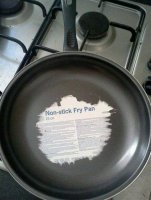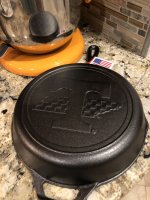You are using an out of date browser. It may not display this or other websites correctly.
You should upgrade or use an alternative browser.
You should upgrade or use an alternative browser.
Vols cast iron
- Thread starter Nouveaux
- Start date
ptcarter
Boomshanka! (Google that)
- Joined
- Nov 26, 2012
- Messages
- 5,868
- Likes
- 13,341
Chilmonty
Obviously, ESPN HATES US!
- Joined
- Oct 5, 2007
- Messages
- 6,819
- Likes
- 12,043
JCHateSteve
Herald of the Meteor
- Joined
- Sep 5, 2008
- Messages
- 16,841
- Likes
- 42,781
bigorangecrush89
Well-Known Member
- Joined
- Nov 2, 2009
- Messages
- 1,622
- Likes
- 3,115
LibertyVolance
Well-Known Member
- Joined
- Nov 6, 2006
- Messages
- 1,468
- Likes
- 1,539
Booker512
Well-Known Member
- Joined
- Oct 3, 2016
- Messages
- 2,496
- Likes
- 5,000
SmokinBob
(♀) Team chargervol
- Joined
- Nov 14, 2012
- Messages
- 9,818
- Likes
- 36,714
I never owned one, but I am interested in buying this one. Does it require curing? Are they hard to clean or would a spray of Pam make scrubbing unnecessary? I think I have heard that washing these with soap ruins the curing process.
Seasoning a Cast Iron Skillet
Get ready: Gather your supplies and then preheat oven to 350°F.
Wash the skillet: Wash the skillet with warm, soapy water and a sponge or stiff brush. Cast iron should not normally be washed with soap, but it's fine here since the pan is about to be seasoned.
Rinse and dry: Rinse and thoroughly dry the skillet with a clean, dry cloth or paper towels.
Add oil: Pour a little vegetable oil or melted shortening into the skillet. A tablespoon or two is plenty. Vegetable oil and shortening are the most commonly recommended oils used for seasoning, but according to Lodge, you can use any oil of your choice
Rub: Use a clean cloth or paper towel to rub the coat around the entire skillet.
Flip the skillet over: Don't forget the outside — and bottom — of the skillet. You want a thin coat of oil around the entire piece.
Bake the skillet: Place the skillet upside down on the oven's center rack. Place a sheet of aluminum foil below the rack to catch any drips. Bake for an hour.
Let the skillet cool: Turn off the heat and allow to the skillet to cool completely before removing from oven. Once it's cooled down, you're good to go!
**A seasoned skillet is smooth, shiny, and nonstick. You'll know it's time to re-season if food sticks to the surface or if the skillet appears dull or rusted.
ProudVOLfan
Too cool for tweeter
- Joined
- Sep 11, 2012
- Messages
- 2,463
- Likes
- 5,791
Jnunn
Cautiously Pessimistic
- Joined
- Jul 12, 2013
- Messages
- 572
- Likes
- 1,053
Seasoning a Cast Iron Skillet
Get ready: Gather your supplies and then preheat oven to 350°F.
Wash the skillet: Wash the skillet with warm, soapy water and a sponge or stiff brush. Cast iron should not normally be washed with soap, but it's fine here since the pan is about to be seasoned.
Rinse and dry: Rinse and thoroughly dry the skillet with a clean, dry cloth or paper towels.
Add oil: Pour a little vegetable oil or melted shortening into the skillet. A tablespoon or two is plenty. Vegetable oil and shortening are the most commonly recommended oils used for seasoning, but according to Lodge, you can use any oil of your choice
Rub: Use a clean cloth or paper towel to rub the coat around the entire skillet.
Flip the skillet over: Don't forget the outside — and bottom — of the skillet. You want a thin coat of oil around the entire piece.
Bake the skillet: Place the skillet upside down on the oven's center rack. Place a sheet of aluminum foil below the rack to catch any drips. Bake for an hour.
Let the skillet cool: Turn off the heat and allow to the skillet to cool completely before removing from oven. Once it's cooled down, you're good to go!
**A seasoned skillet is smooth, shiny, and nonstick. You'll know it's time to re-season if food sticks to the surface or if the skillet appears dull or rusted.
A true East Tennessean should have ready to go, seasoned skillets in at least two sizes, preferably with a well-seasoned stove top cast iron grill as well. Its critical to make your Sunday morning gravy with a helping of the bacon grease left in the pan from your pig. If you are a true pro, you will have already made the biscuits in your other cast iron.
Also, its awesome to make campfire meals in your cast iron on the smoldering embers left over from a fire.
Smokey X
Well-Known Member
- Joined
- Jan 16, 2016
- Messages
- 2,501
- Likes
- 4,828
Seasoning a Cast Iron Skillet
Get ready: Gather your supplies and then preheat oven to 350°F.
Wash the skillet: Wash the skillet with warm, soapy water and a sponge or stiff brush. Cast iron should not normally be washed with soap, but it's fine here since the pan is about to be seasoned.
Rinse and dry: Rinse and thoroughly dry the skillet with a clean, dry cloth or paper towels.
Add oil: Pour a little vegetable oil or melted shortening into the skillet. A tablespoon or two is plenty. Vegetable oil and shortening are the most commonly recommended oils used for seasoning, but according to Lodge, you can use any oil of your choice
Rub: Use a clean cloth or paper towel to rub the coat around the entire skillet.
Flip the skillet over: Don't forget the outside — and bottom — of the skillet. You want a thin coat of oil around the entire piece.
Bake the skillet: Place the skillet upside down on the oven's center rack. Place a sheet of aluminum foil below the rack to catch any drips. Bake for an hour.
Let the skillet cool: Turn off the heat and allow to the skillet to cool completely before removing from oven. Once it's cooled down, you're good to go!
**A seasoned skillet is smooth, shiny, and nonstick. You'll know it's time to re-season if food sticks to the surface or if the skillet appears dull or rusted.
One additional item...after each use it is best to wipe it out gently ( I use paper towels) just enough to clean the residue out. Don't scrub it or use strong cleaning solutions and especially don't put in dishwasher. Otherwise, you willhave to season it all over. The more you use it, the more it seasons.
ptcarter
Boomshanka! (Google that)
- Joined
- Nov 26, 2012
- Messages
- 5,868
- Likes
- 13,341
HuntlandVolinColo
Rocky Top High Colorado
- Joined
- Feb 27, 2011
- Messages
- 14,870
- Likes
- 11,845
HoptownVol
Well-Known Member
- Joined
- Aug 21, 2014
- Messages
- 8,192
- Likes
- 5,792
greenbacknative
Well-Known Member
- Joined
- Nov 25, 2015
- Messages
- 2,839
- Likes
- 3,740
PineyBluff Vol
Senior Member
- Joined
- Nov 5, 2005
- Messages
- 4,319
- Likes
- 2,297
0nelilreb
Don’t ask if you don’t want the truth .
- Joined
- Jun 29, 2010
- Messages
- 28,325
- Likes
- 45,438
Not sure how many fans of cast iron we have in here but Lodge just announced a Collegiate series and, of course, UT is the first one featured. Pretty sweet: LINK
I just wanted to thank you for this thread , I had forgotten all about the Lodge store . Just ordered ... the Tennessee 10.25, the Dutch oven combo with the skillet lid and the 7 piece corn pone cast . I’m excited like a kid waiting for Christmas to get here now .
- Joined
- Feb 21, 2005
- Messages
- 22,145
- Likes
- 3,970
Advertisement






